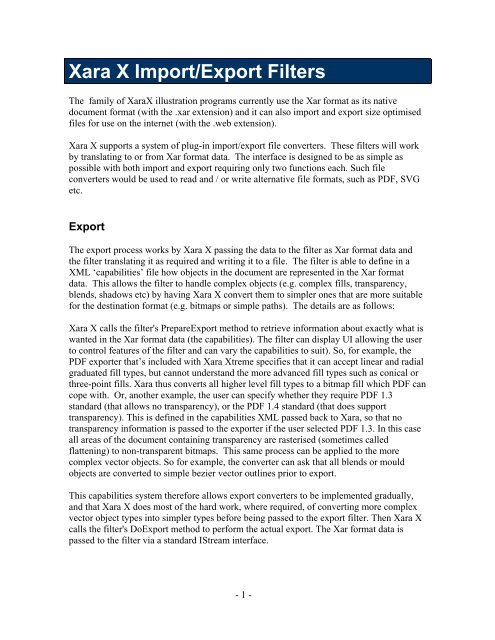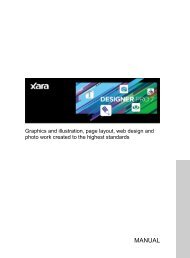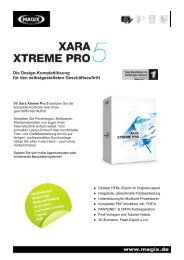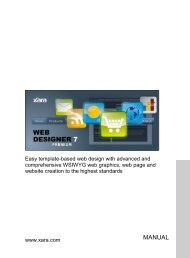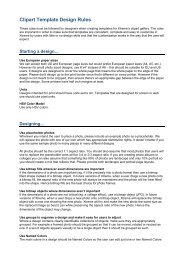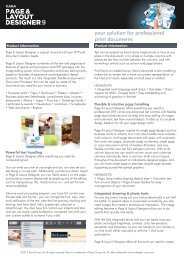Xar Format Specification - Xara
Xar Format Specification - Xara
Xar Format Specification - Xara
Create successful ePaper yourself
Turn your PDF publications into a flip-book with our unique Google optimized e-Paper software.
<strong>Xar</strong>a X Import/Export FiltersThe family of <strong>Xar</strong>aX illustration programs currently use the <strong>Xar</strong> format as its nativedocument format (with the .xar extension) and it can also import and export size optimisedfiles for use on the internet (with the .web extension).<strong>Xar</strong>a X supports a system of plug-in import/export file converters. These filters will workby translating to or from <strong>Xar</strong> format data. The interface is designed to be as simple aspossible with both import and export requiring only two functions each. Such fileconverters would be used to read and / or write alternative file formats, such as PDF, SVGetc.ExportThe export process works by <strong>Xar</strong>a X passing the data to the filter as <strong>Xar</strong> format data andthe filter translating it as required and writing it to a file. The filter is able to define in aXML ‘capabilities’ file how objects in the document are represented in the <strong>Xar</strong> formatdata. This allows the filter to handle complex objects (e.g. complex fills, transparency,blends, shadows etc) by having <strong>Xar</strong>a X convert them to simpler ones that are more suitablefor the destination format (e.g. bitmaps or simple paths). The details are as follows:<strong>Xar</strong>a X calls the filter's PrepareExport method to retrieve information about exactly what iswanted in the <strong>Xar</strong> format data (the capabilities). The filter can display UI allowing the userto control features of the filter and can vary the capabilities to suit). So, for example, thePDF exporter that’s included with <strong>Xar</strong>a Xtreme specifies that it can accept linear and radialgraduated fill types, but cannot understand the more advanced fill types such as conical orthree-point fills. <strong>Xar</strong>a thus converts all higher level fill types to a bitmap fill which PDF cancope with. Or, another example, the user can specify whether they require PDF 1.3standard (that allows no transparency), or the PDF 1.4 standard (that does supporttransparency). This is defined in the capabilities XML passed back to <strong>Xar</strong>a, so that notransparency information is passed to the exporter if the user selected PDF 1.3. In this caseall areas of the document containing transparency are rasterised (sometimes calledflattening) to non-transparent bitmaps. This same process can be applied to the morecomplex vector objects. So for example, the converter can ask that all blends or mouldobjects are converted to simple bezier vector outlines prior to export.This capabilities system therefore allows export converters to be implemented gradually,and that <strong>Xar</strong>a X does most of the hard work, where required, of converting more complexvector object types into simpler types before being passed to the export filter. Then <strong>Xar</strong>a Xcalls the filter's DoExport method to perform the actual export. The <strong>Xar</strong> format data ispassed to the filter via a standard IStream interface.- 1 -
ImportThe import process works in a similar way to the export process. <strong>Xar</strong>a X passes thefilename of the file to be imported and the filter must read the data and translate it into <strong>Xar</strong>format data. The details are as follows:<strong>Xar</strong>a X calls the filter's HowCompatible method to discover whether the particular filtercan handle the file. If the filter type was not specified in the <strong>Xar</strong>aX import dialog (or a filewas dragged and dropped) then <strong>Xar</strong>a X will call this method on each registered import filterand will use the one that scores the highest.<strong>Xar</strong>a X calls the filter's DoImport method to perform the actual import. The filename of thefile being imported is passed to the filter and the <strong>Xar</strong> format data must be written to thestandard IStream interface.Implementing a Filter ObjectWhen using C++ (or any other language that allows linking to C++ static libraries) theeasiest way to implement a <strong>Xar</strong> file Reader or Writer is to use the <strong>Xar</strong>Lib library. Thelibrary provides access to a <strong>Xar</strong> file at the record level for both the reading and writing of<strong>Xar</strong> format files. The library is responsible for handling the ZLib compression and certainother features of the format (e.g. atomic and essential records) leaving you to deal withinterpreting or writing the records without having to worry about the low-level details.The library is currently only available as header files and static libraries built withMicrosoft Visual C++ 6 (multi-threaded C runtime versions for debug and release). Otherversions, including source code that can be built on other platforms, should be madeavailable shortly.Download the <strong>Xar</strong>Lib Library (643 KB)The XPFilter archive contains a simple example filter object (XPFStats) that uses the<strong>Xar</strong>Lib library to handle the reading and writing of the <strong>Xar</strong> format data and a test bedprogram (FilterDemo) for testing the filters.Download the XPFilter archive (106 KB)All of the files in these downloads are copyright <strong>Xar</strong>a Group Ltd 2005. You are free to usethem for any purpose.- 2 -
XPFStatsThe XPFStats project is an example filter built using Microsoft VC++ 6, ATL and the<strong>Xar</strong>Lib library. On export, it creates a text file containing a list of how many times eachrecord "Tag" appears in the <strong>Xar</strong> data. On import it converts a text file into a <strong>Xar</strong> documentcontaining a text story consisting of the text from the file. This project uses the <strong>Xar</strong>Liblibrary for both reading and writing of the <strong>Xar</strong> format data making it a useful example ofhow to use the library.FilterDemoFilterDemo.exe is a simple test-bed application for developing filter objects. It uses thefilter objects in the same way as <strong>Xar</strong>aX but it provides the <strong>Xar</strong> data for export from a <strong>Xar</strong>file you specify and on import it writes out the <strong>Xar</strong> data the filter object creates to a file.- 3 -


